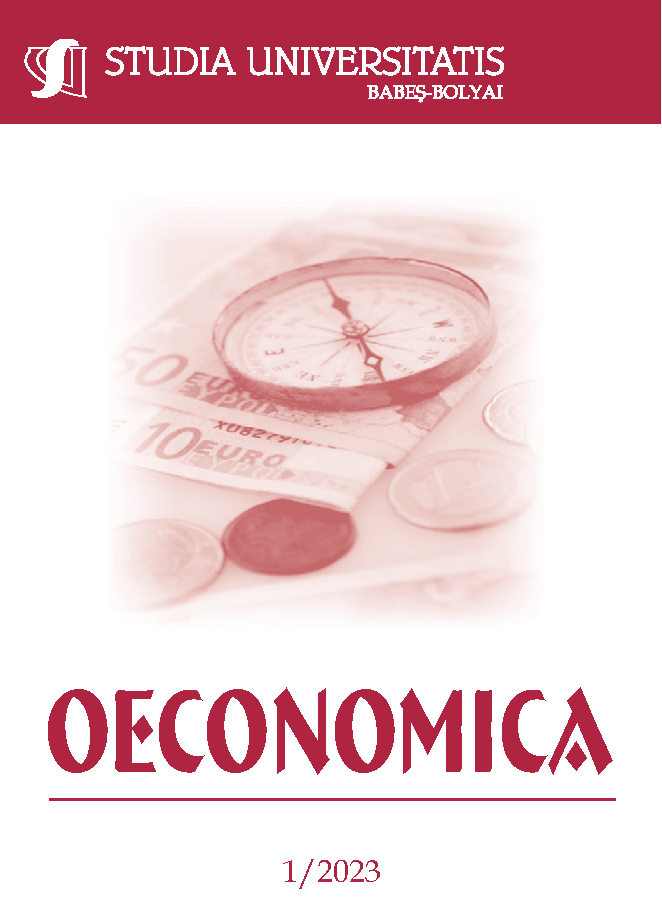HERDING BEHAVIOR IN FRONTIER NORDIC COUNTRIES
DOI:
https://doi.org/10.2478/subboec-2023-0002Keywords:
Herding behavior; Market states; Financial Crises; Cross-sectional absolute deviation of returnsAbstract
This paper investigates herding behavior of investors in three frontier Nordic countries from July 1, 2002 until July 30, 2021, under different market conditions and during three crises that occurred in this period. As estimation methods, we use both OLS and quantile regression and determine that both up and down market, high and low volatility induce a weak herding behavior for at least one quantile in almost all Nordic countries examined, except for Latvia. At the same time, we find that crises determine a more prominent herding behavior in Nordic countries, but do not influent the behavior of investors from Latvia, that tend to remain rational even in stressful conditions.
JEL Classification: G01, G14, G40
References
Banerjee, A.V. (1992), A Simple Model of Herd Behavior, Quarterly Journal of Economics, 107 (3), pp. 797-817.
Barnes, M.L. and Hughes., A. (2002), A Quantile Regression Analysis of the Cross Section of Stock Market Returns, Working Paper, SSRN Electronic Journal.
Bikhchandani, S., Hirshleifer, D., Welch, I. (1992), A Theory of Fads, Fashion, Custom, and Cultural Change as Informational Cascades, Journal of Political Economy, 100, pp. 992-1026.
Bikhchandani, S. and Sharma, S. (2000), Herd Behavior in Financial Markets, Working paper, IMF Institute.
Blasco, N., Corredor, P., and Ferreruela, S. (2012), Does herding affect volatility? Implications for the Spanish stock market, Quantitative Finance, 12(2), pp. 311–327.
Chang, E., Cheng, J. and Khorana., A. (2000), An Examination of Herd Behavior in Equity Markets: An International Perspective, Journal of Banking and Finance, 24, pp. 1651-1679.
Chiang, T. C., and Zheng, D. (2010), An Empirical Analysis of Herd Behavior in Global Stock Markets, Journal of Banking & Finance, 34 (8), pp. 1911–1921.
Choijil, E., Méndez, C.E., Wong, W.K., Vieito, J.P., Batmunkh, M.U. (2021), Thirty years of Herd Behavior in Financial Markets: A Bibliometric Analysis, Research in International Business and Finance, 59, 101506.
Choi, S. (2016), Herding among local individual investors: Evidence from online and offline trading, Economics Letters, 144, pp. 4-6.
Chen, Y.C., Kuo, S.M. and Yang, Y.W. (2020), Is Herding a Safe Haven for Investment?, Applied Economics Letters, pp. 1-5.
Christie, W. G., and R. D. Huang. (1995), Following the Pied Piper: Do Individual Returns Herd around the Market?, Financial Analysts Journal, 51, pp. 31–37.
Coskun, E.A., Lau, C.K.M., and Kahyaoglu, H. (2020), Uncertainty and Herding Behavior: Evidence from Cryptocurrencies, Research in International Business and Finance, 54, 101284.
Cuñado, J., Gil-Alana, L.A. and Perez de Gracia, F. (2007), Testing for Stock Market Bubbles Using Nonlinear Models and Fractional Integration, Applied Financial Economics, 17, pp.1313-1321.
Demirer, R. and Kutan, A.M. (2006), Does Herding Behavior Exist in Chinese Stock Markets?, Journal of International Financial Markets, Institutions and Money, 16(2), pp.123-142.
Devenow, A. and Welch, I. (1996), Rational Herding in Financial Economics, European Economic Review, 40, pp. 603-615.
Duygun, M., Tunaru, R. and Vioto, D. (2021), Herding by Corporates in the US and the Eurozone through Different Market Conditions, Journal of International Money and Finance, 110, pp. 102311.
Economou, F., Kostakis, A. and Philippas, N. (2018), Cross-country Effects in Herding Behaviour: Evidence from Four European Markets, Journal of International Financial Markets, Institutions and Money, 21(3), pp. 443-460.
Fernández, B., Garcia-Merino, T., Mayoral, R. Santos, V. and Vallelado, E. (2011), Herding, Information Uncertainty and Investors' Cognitive Profile, Qualitative Research in Financial Markets, 3(1), pp. 7-33.
Filip, A.M., Pece, A.M. and Pochea, M.M. (2015), An Empirical Investigation of Herding Behavior in CEE Stock Markets under the Global Financial Crisis, Procedia Economics and Finance, 25, pp. 354-361.
Galariotis, E.C., Krokida, S. and Spyrou, S.I. (2016), Herd behavior and equity market liquidity: Evidence from major markets, International Review of Financial Analysis, 48, pp. 140-149.
Galariotis, E.C., Rong, W. And Spyrou, S.I. (2015), Herding on fundamental information: A comparative study, Journal of Banking and Finance, 50, pp. 589-598.
Guo, J., Holmes, P. and Altanlar, A. (2020), Is Herding Spurious or Intentional? Evidence from Analyst Recommendation Revisions and Sentiment, International Review of Financial Analysis, 71, 101539.
Hirshleifer, D. and Teoh, S.H. (2003), Herd Behavior and Cascading in Capital Markets: a Review and Synthesis, European Financial Management, 9, pp. 25-66.
Hwang, S. and Salmon, M. (2004), Market Stress and Herding, Journal of Empirical Finance, 11(4), pp. 585-616.
Javed, H., Bagh, T. and Razzaq, S. (2017), Herding Effects, Over Confidence, Availability Bias and Representativeness as Behavioral Determinants of Perceived Investment Performance: An Empirical Evidence from Pakistan Stock Exchange (PSX), Journal of Global Economics, 6(1), pp. 1000275.
Kaliva, K. and Koskinen, L. (2008), Stock Market Bubbles, Inflation and Investment Risk, International Revies of Financial Analysis, 17(3), pp. 592-603.
Khan, H., Hassairi, S.A. and Viviani, J.L. (2011), Herd Behavior and Market Stress: The Case of Four European Countries, International Business Research, 4(3), pp. 53-68.
Kreuser, J., and Sornette, D. (2017), Super-Exponential RE Bubble Model with Efficient Crashes. Working paper, University of Geneva, Switzerland.
Lao, P. and Singh, H. (2011), Herding Behavior in the Chinese and Indian Stock Markets, Journal of Asian Economics, 22(6), pp. 495-506.
Maug, E. and Naik, N.Y. (1995), Herding and Delegated Portfolio Management: The Impact of Relative Performance Evaluation on Asset Allocation. Working paper, London Business School.
Pochea, M.M., Filip, A.M. and Pece, A.M. (2017), Herding Behavior in CEE Stock Markets under Asymmetric Conditions: A Quantile Regressions Analysis, Journal of Behavioral Finance, pp. 1-17.
Scharfstein, D.S., and Stein, J.C. (1990), Herd Behavior and Investment, The American Economic Review, 80, 465–479.
Spyrou, S.I. (2013), Herding in Financial Markets: a Review of the Literature, Review of Behavioral Finance, 5(2), pp. 175-194.
Yao, C.Z., Li, H.Y. (2020), Time-varying lead–lag structure between investor sentiment and stock market, The North American Journal of Economics and Finance, 52, pp. 101148.
Downloads
Published
How to Cite
Issue
Section
License
Copyright (c) 2023 Studia Universitatis Babeș-Bolyai Oeconomica

This work is licensed under a Creative Commons Attribution-NonCommercial-NoDerivatives 4.0 International License.






